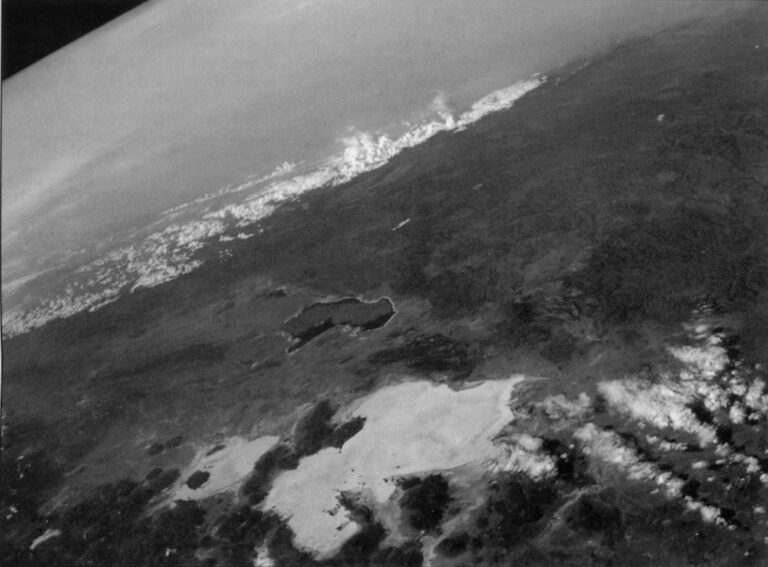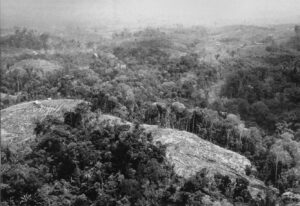Ichoa, Bolivia – The yap of a toucan sounded from a treetop near the Ichoa ranger post in Bolivia’s Isiboro-Secure National Park. From the cabin’s porch, park director Hans Rocha picked out the bird’s long-billed silhouette, framed against the foothills of the Andes, where the park’s western boundary lies. In the park’s 2.75 million acres, stretching from lowland rain forest to 13,000-foot high mountain slopes, species as common as the toucan and as rare as the harpy eagle thrive.
Co-managed by native tribes, who in 1990 won recognition of the park as an “Indigenous Territory,” most of Isiboro-Secure is still pristine. But around Ichoa, in the southeastern corner of the park, the forest has been largely destroyed. Near the ranger post, fallen trees smolder, while in hundreds of other fields, rows of green bushes have replaced the rain forest. They are among the estimated 15,000 acres of parkland burned down to make way for coca, the raw material for cocaine.

There have been coca fields and processing labs in the Isiboro-Secure National Park and Indigenous Territory for at least ten years, but recently the park has become propaganda fodder in the Bolivian government’s anti-narcotics effort. Pushed by the U.S. to step up the pace of its coca eradication program, the government promises a frontal assault on the coca in the park, which it says is both illegal and an environmental disaster. For their part, the colonists threaten to resist, violently if necessary. But there is a disturbing Catch-22 behind this war of words: rapid eradication might do as much harm as coca itself. Unfortunately, conservationists, despite their concern about tropical forests, have paid little heed to the drug war and its environmental consequences.
Bolivia is the world’s second largest producer of coca leaf, growing 120,000 acres, most of it in the Chapare region and neighboring Isiboro-Secure. In March 1995, the U.S. government, which in the past decade fruitlessly spent $186 million trying to cut coca production (another $259 million went to military and police aid during the past five years), issued an ultimatum: Bolivia would either eradicate 4,375 acres of coca by June 30, or face a cutoff in aid. Worse still, the U.S. would block international loans to Bolivia.
Even the radical Chapare coca growers’ union buckled under the threat, and farmers eradicated over 5,000 acres. The U.S. demands they eradicate an additional 7,500 acres by the end of 1995.
Faced with such unrelenting pressure, Bolivia’s government seized on Isiboro-Secure in the hope that Bolivians may support stepped-up eradication if they believe coca is an environmental catastrophe. Most Bolivians believe the coca growers when they say that despite the $221 million invested in finding alternatives over the past 10 years, coca is still their only hope for survival. That public sympathy has hamstrung eradication efforts.
The U.S. government tried to use environmental concerns in similar fashion in 1987, when it sought to convince Peruvians that herbicidal eradication of coca would be less harmful than the crop itself. The effort failed, but with conservation groups silent on the pros and cons of eradication, governments still dominate the debate on coca and the environment.
“As conservation institutions, we’ve closed our eyes to the problem of coca,” said Conservation International’s Bolivian representative, Guillermo Riojas. Though his Washington-based organization labels the tropical Andes one of the world’s three top conservation priorities, no international group has included the drug issue in its programs.
This has meant ignoring places like Isiboro-Secure, whose environment of warm, wet slopes and valleys is ideal for both growing coca and fostering biological diversity. Isiboro-Secure, for instance, is home to 600 bird species, compared to just 850 for the United States and Canada combined.
In Bolivia’s current environmental blitz, the most strident voice against the coca farmers is Government Minister Carlos Sanchez Berzain, who ordered the formation of a new “ecological police” brigade to fight drugs in national parks. Waldo Vargas, Bolivia’s Secretary of the Environment, said the government plans to move coca growers out of Isiboro-Secure and settle them elsewhere.
No one doubts that coca and cocaine threaten South America’s tropical forests. Throughout the continent, 1.75 million acres of forest may have been destroyed in the coca boom, and the labs which make cocaine base use enormous quantities of toxic chemicals. But little is known about the precise impact of the drug trade, much less about what eradicating the coca crop will do.
In 1989, Jose Lorini, an engineer at Bolivia’s Center for Ecological Studies and Integrated Development, took part in a U.S.-funded study of coca production in the Yungas region. There, farmers grow coca for the legal market, using techniques perfected centuries ago. He found coca well-adapted to the Andean tropics. Lorini said that “without the traditional systems, coca is a disaster,” but he added that the practice of tearing the bush up at the roots may do even more damage. “It’s practically impossible to grow other crops on land where coca has been eradicated,” he said.
Lorini’s study offered little insight on the impact of the illegal coca industry, which has abandoned traditional growing practices and processes the leaf with kerosene, sulfuric acid, potassium permanganate and other chemicals. In 1992, the United States Agency for International Development (USAID) financed another study, by the California-based Southwest Research Associates, on the environmental impact of illegal coca production and processing in the Chapare. Oddly, U.S. government officials in Washington and La Paz have repeatedly claimed that no such study exists.
Titled “Environmental and Ecological Effects of the Coca Conversion Industry” and published in 1993, the study found coca’s worst impact to be deforestation, though it questioned official figures. The study also found that though processing the leaf severely pollutes laboratory sites, “the immense quantities of rain that fall on the Chapare each year serve to dilute contamination.”
Roberto Laserna, of the Bolivian think tank CERES, who wrote his doctoral dissertation on the Chapare drug trade, said the U.S. and Bolivian governments deliberately inflate the environmental impact of the coca trade. “If you bring up environmental issues, you’ll get more support for anti-drug programs,” he said.
Laserna believes many impoverished highlanders would have colonized the Chapare even without the coca boom, driven by the economic crisis which devastated Bolivian mining and agriculture in the mid-1980s. “Obviously, every hectare of coca is a hectare less of forest. But a hectare of any other crop is also a hectare less of forest,” he said. “And to live on coca, the farmer deforests less land than he would with other products.”
According to the 1993 study, “the very small farms needed to sustain a living wage based on coca cultivation are significantly smaller than the size of non-coca based farms required to generate an equivalent level of income.” Without coca, twice as much deforested land might be needed to support the Chapare’s current population.

Even the natives of Isiboro-Secure, whose land the coca farmers invaded, feel some sympathy for the growers. Though today they number only about 3500 families, at the height of the coca boom some 7,000 families of coca growers invaded 230,000 acres of indigenous territory. Yet instead of demanding that the government boot the colonists out, the natives sought a compromise.
In 1992, with support from USAID, a group of natives and colonists drew up, and then hacked out of the forest, what is known as the “Red Line” separating areas where the colonists live from the rest of the park. In exchange for the right to settle, the farmers renounced claims to the land and promised to respect the Red Line.
According to Hans Rocha, the coca farmers have scrupulously policed the line. Despite accusations by his own government to the contrary, he insists that “no one has crossed the line.”
“We shouldn’t ignore the needs of other people,” said Marcial Fabricano, a native leader who spearheaded the Red Line effort. But he is discouraged by the colonists’ continuing reliance on coca. A U.S. – funded program pays farmers $1,000 for each acre of coca they voluntarily eradicate, but many farmers who do so simply plant new fields, claiming they have no other way to survive.
Throughout the Chapare, from 1986 to 1994, coca growers voluntarily eradicated 63,670 acres, then planted 83,352 acres of new coca. Riojas said parks are a favorite target for new fields. “It’s as if we were conserving for the traffickers,” he said.
Waldo Vargas worries that without massive aid, growers whose fields are eradicated in Isiboro-Secure “might just move into other protected areas. That’s why we need international help,” he said.
He is unlikely to get it. Both the U.S. and the United Nations plan to cut funding for alternative development in Bolivia. And with the international conservation community turning a blind eye, places like Isiboro-Secure may be, as Guillermo Riojas fears, “already lost.”
©1996 Corinne Schmidt
Corinne Schmidt is a freelance writer in Peru examining the environmental consequences of the cocaine trade.



